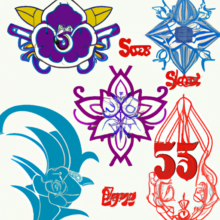How Tattoos Are Made
Tattoos have been a form of self-expression and body art for centuries. From ancient civilizations to modern times, people have been adorning their bodies with permanent ink designs. But have you ever wondered how tattoos are made? In this article, we will take a closer look at the process of tattooing and how these beautiful works of art are created.
The first step in getting a tattoo is choosing a design. This can be a personal creation or something chosen from a tattoo artist’s portfolio. Once the design is finalized, the tattoo artist will create a stencil of the design. This stencil is then transferred onto the skin using a special transfer paper and a stencil fluid. This ensures that the design is accurately placed on the skin before the tattooing process begins.
The next step is preparing the equipment. The tattoo artist will use a tattoo machine, also known as a tattoo gun, which consists of a needle attached to a tube. The needle is dipped into ink and then inserted into the machine. The machine is powered by a motor that moves the needle up and down at a high speed, allowing the ink to penetrate the skin.
Before starting the tattoo, the artist will clean and disinfect the area where the tattoo will be placed. This is crucial to prevent any infections or complications. The artist will also wear gloves throughout the entire process to maintain a sterile environment.
Now, it’s time for the actual tattooing to begin. The artist will start by outlining the design using a single needle. This creates a thin, precise line that will serve as a guide for the rest of the tattoo. The artist will then switch to a larger needle to fill in the design with shading and color. The needle penetrates the skin at a depth of 1/16th of an inch, depositing the ink into the dermis, the second layer of skin.
The process of tattooing can be uncomfortable and even painful, depending on the individual’s pain tolerance. Some people compare the sensation to a constant scratching or stinging feeling. However, many tattoo artists use a numbing cream or spray to help alleviate the discomfort.
As the tattoo is being created, the artist will periodically wipe away excess ink and blood with a clean, damp cloth. This allows them to see the progress of the tattoo and make any necessary adjustments. Once the tattoo is complete, the artist will clean the area again and apply a thin layer of ointment to help with healing.
Aftercare is crucial for the healing process of a tattoo. The artist will provide instructions on how to properly care for the tattoo, which typically includes keeping it clean and moisturized. It’s essential to avoid picking or scratching at the tattoo, as this can cause damage and affect the final result.
The healing process can take anywhere from two to four weeks, depending on the size and location of the tattoo. During this time, the tattoo will go through various stages, including scabbing and peeling. It’s essential to follow the aftercare instructions to ensure the tattoo heals properly and maintains its vibrant colors.
In conclusion, tattoos are made through a process that involves careful planning, preparation, and skillful execution. From choosing a design to the final healing process, every step is crucial in creating a beautiful and long-lasting tattoo. So the next time you admire someone’s tattoo, remember the intricate process that went into making it. And if you’re considering getting a tattoo yourself, make sure to do your research and choose a reputable and experienced tattoo artist to ensure a safe and successful experience.



